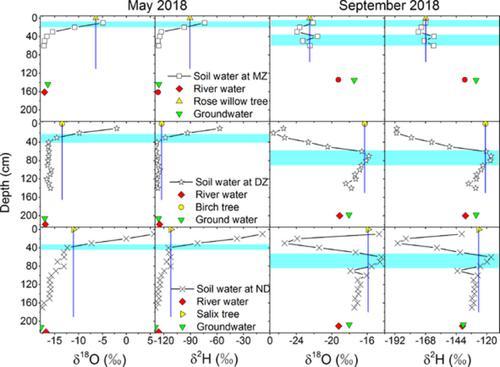当前位置:
X-MOL 学术
›
Hydrol. Process.
›
论文详情
Our official English website, www.x-mol.net, welcomes your
feedback! (Note: you will need to create a separate account there.)
Water uptake of riparian plants in the lower Lhasa River Basin, South Tibetan Plateau using stable water isotopes
Hydrological Processes ( IF 2.8 ) Pub Date : 2020-06-21 , DOI: 10.1002/hyp.13831 Wenbo Rao 1 , Xi Chen 2 , Karina T. Meredith 3 , Hongbing Tan 1 , Man Gao 4 , Jintao Liu 2
Hydrological Processes ( IF 2.8 ) Pub Date : 2020-06-21 , DOI: 10.1002/hyp.13831 Wenbo Rao 1 , Xi Chen 2 , Karina T. Meredith 3 , Hongbing Tan 1 , Man Gao 4 , Jintao Liu 2
Affiliation

|
Riparian plants can adapt their water uptake strategies based on climatic and hydrological conditions within a river basin. The response of cold‐alpine riparian trees to changes in water availability is poorly understood. The Lhasa River is a representative cold‐alpine river in South Tibet and an under‐studied environment. Therefore, a 96 km section of the lower Lhasa River was selected for a study on the water‐use patterns of riparian plants. Plant water, soil water, groundwater and river water were measured at three sites for δ18O and δ2H values during the warm‐wet and cold‐dry periods in 2018. Soil profiles differed in isotope values between seasons and with the distance along the river. During the cold‐dry period, the upper parts of the soil profiles were significantly affected by evaporation. During the warm‐wet period, the soil profile was influenced by precipitation infiltration in the upper reaches of the study area and by various water sources in the lower reaches. Calculations using the IsoSource model indicated that the mature salix and birch trees (Salix cheilophila Schneid. and Betula platyphylla Suk.) accessed water from multiple sources during the cold‐dry period, whereas they sourced more than 70% of their requirement from the upper 60–80 cm of the soil profile during the warm‐wet period. The model indicated that the immature rose willow tree (Tamarix ramosissima Ledeb) accessed 66% of its water from the surface soil during the cold‐dry period, but used the deeper layers during the warm‐wet period. The plant type was not the dominant factor driving water uptake patterns in mature plants. Our findings can contribute to strategies for the sustainable development of cold‐alpine riparian ecosystems. It is recommended that reducing plantation density and collocating plants with different rooting depths would be conducive to optimal plant growth in this environment.
更新日期:2020-06-21











































 京公网安备 11010802027423号
京公网安备 11010802027423号